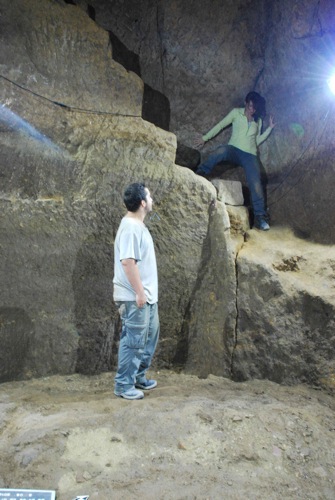The first ever Etruscan pyramids have been located underneath a wine cellar in the city of Orvieto in central Italy. A team of Italian and US archeologists are working to uncover the remains of what has turned out to be an amazing discovery.
They discovered pyramids dating to at least the 5th Century BCE carved into the rock of the Tufa plateau ( a sedimentary area that is a result of volcanic activity) on which Orvieto stands, the subterranean structures were largely filled. Only the top-most modern layer was visible.
The archaeologists and students uncovered a series of Etruscan tunnels, 5th century BCE Etruscan pottery, as well as material dating back to 1200 BCE. George believes the subterranean pyramids were likely tombs or part of a sanctuary. He says there are no parallels to this anywhere in Italy.
“We know its not a quarry or a cistern; the walls are too well dressed to be a quarry and there is no evidence of mud which would point to a cistern. That leaves just a couple of things, some sort of a religious structure or a tomb, both of which are without precedent here,” says George.
At the time of their discovery, the structures were filled, covered by a top floor that had been modified for modern use, most currently, a wine cellar. Upon noting some Etruscan construction techniques in the stone stairwell, Drs. George and Bizzarri obtained a permit to dig deeper.
As they started digging, David B.George of the Department of Classics at Saint Anselm and co-director of the excavation Claudio Bizzarri of the Parco Archeologico Ambientale dell'Orvietano noted that the cave's walls were tapered up in a pyramidal fashion. Intriguingly, a series of tunnels, again of Etruscan construction, ran underneath the wine cellar hinting to the possibility of deeper undiscovered structures below.
Excavation of the site began on May 21 where the group dug through a mid 20th century floor reaching a medieval floor. Immediately beneath this subfloor, George and Bizzarri with their team excavated a layer of fill containing materials and artifacts ranging from the middle of the 5th century BCE to 1000 BCE.
Digging through this layer, the archaeologists found 5 feet of gray sterile fill, which was intentionally deposited from a hole in the top of the structure.
"Below that material there was a brown layer that we are currently excavating. Intriguingly, the stone carved stairs run down the wall as we continue digging. We still don't know where they are going to take us," Bizzarri told Discovery News.
The material from the deepest level reached so far (the archaeologists have pushed down about 10 feet) dates to around the middle of the fifth century B.C.
"At this level we found a tunnel running to another pyramidal structure and dating from before the 5th century B.C. which adds to the mystery," George said.
According to Bizzarri, there are at least five Etruscan pyramids under the city. Three of these structures have yet to be excavated
According to George, the underground pyramids could represent some sort of a religious structure or a tomb. In both cases, it would be a discovery without precedent.
"Most likely, the answer waits at the bottom. The problem is we don't really know how much we have to dig to get down there," Bizzarri said.
The site will sit idle until May 2013, when Drs. George and Bizzarri return with their crews.
Etruscan tribes are one of the biggest mysteries of antiquity for the scientists.
The Etruscans were a pre-Roman civilization who lived in Etruria, in what is now western Umbria, southern Tuscany, and northern Lazio. They created a well-developed culture, which exerted great influence on the Roman civilization. The Romans borrowed engineering art from the Etruscans, a part of religious ceremonies and even gladiator fights.
Known for their art, agriculture, fine metalworking and commerce, they flourished atound 900 B.C. and started to decline during the fifth century B.C., as the Romans grew in power. By 300-100 B.C., they eventually became absorbed into the Roman empire.
One of the top Etruscan places to visit today is Cerveteri and the surrounding area.








